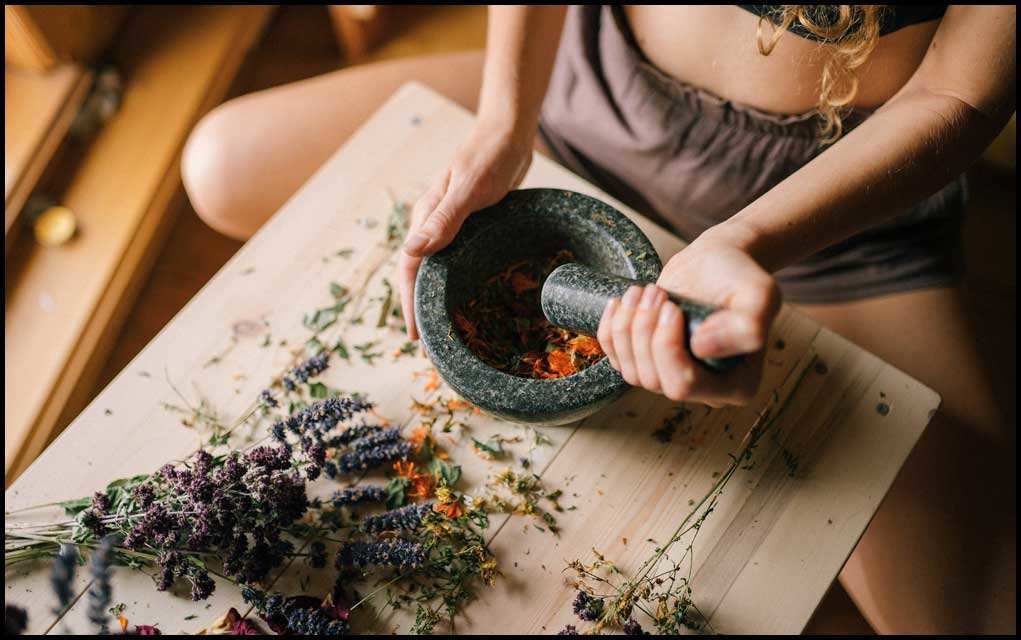
A poultice, also called a cataplasm, is a paste made of herbs, plants, and other substances with healing properties. The paste is spread on a warm, moist cloth and applied to the body to relieve inflammation and promote healing. Some can be spread directly on the skin.
This popular home remedy has been used for centuries to treat inflammation, insect bites, and more.
Poultice Benefits And Uses
When using a poultice, you not only get the benefits of the ingredients used, but the method itself. The warm poultice increases blood flow to the area, which is an important part of healing.
Poultice For Abscess
An abscess, also called a boil, is a collection of pus that forms due to a bacterial infection. A poultice has been a popular home remedy for the treatment of abscesses for centuries. The moist heat from a poultice can help to draw out the infection and help the abscess shrink and drain naturally.
An Epsom salt poultice is a common choice for treating abscesses in humans and animals. Epsom salt helps to dry out the pus and causes the boil to drain.
Poultice For Infection
A poultice can treat infection by killing bacteria and drawing out the infection. The use of poultices made of herbs, mud, or clay for infection is ancient.
Recently, researchers discovered that a poultice made of OMT Blue Clay may help fight certain types of disease-causing bacteria when applied to wounds. This included some treatment-resistant bacteria.
Poultice For Cyst
A cyst is a sac filled with fluid or a mix of solid substances and fluids. They can grow anywhere on your body or under your skin and range in size, depending on the type.
Applying a warm poultice to a cyst can speed up healing by helping it drain.
Poultice For Diabetic Ulcer
There is evidence of the effectiveness of poultices for diabetic ulcers dating back to the late 1800s. At the time, a poultice containing linseed was used to soften calluses before cutting away the diseased tissue and applying antiseptic.
More recently, a 2016 animal study suggested that a poultice made from the fern Blechnum orientale could be an effective treatment for diabetic ulcers. More research is needed to understand its effects in humans.
Poultice For Arthritis
You may remember a grandparent or great-grandparent smothering a homemade paste over their knee for arthritis. Using herbs for arthritis is a practice that continues to this day.
A 2010 study on 10 adults with osteoarthritis found that applying a warm ginger compress to the kidney area improved pain and stiffness, as well as overall well-being.
Ginger and a number of other plants have been shown to have anti-arthritic, anti-rheumatic, and anti-inflammation properties. Applying a poultice made of herbs for arthritis pain may help relieve inflammation and pain.
Which Herbs And Other Ingredients Work Best?
You have a few options when it comes to ingredients for making poultices. Which will work best depends on what you’re treating.
Herbs
The following are herbs with medicinal properties that can be used to make poultices for a variety of ailments, such as minor skin irritations or abrasions:
Other Ingredients
Other popular ingredients for a DIY poultice include:
- Epsom salt
- aloe vera
- activated charcoal
- baking soda
- milk
- bread
- coconut oil
Precautions For Using A Poultice
An allergic reaction is possible when applying any substance directly on your skin. Test a small area on your forearm before applying the poultice to the affected area.
If you’re applying a poultice to an open wound, be sure to use a clean cloth if making a compress. Do not apply any type of paste or cloth poultice to a wound that appears to be seriously infected.
If you’re making a heated poultice, it should be warm — not hot — to avoid burning your skin.
How To Make A Poultice
You may get relief from a homemade poultice for things such as minor skin irritations or cuts, bruises, or mild pain from arthritis or a minor injury.
Herbal Poultice
Here’s how to make an herbal poultice that can be used to relieve minor inflammation, abrasions, and more.
What you’ll need:
- 1 teaspoon turmeric powder
- 1 ounce freshly chopped or grated ginger
- ¼ small raw sliced onion
- 1 chopped garlic clove
- 2 teaspoons coconut oil
- cheesecloth or cotton bandage
How to do it:
- Add the coconut oil followed by the rest of the ingredients to a pan on low heat and allow it to heat until it’s almost dry — but not burnt.
- Turn off the stove and transfer ingredients to a bowl to cool so that it’s warm to the touch.
- Lay the cloth flat and add the mixture to the center of the cloth.
- Fold the cloth over twice to create a pack or gather it and tie it with some string or a rubber band to create a handle — whatever you prefer as long as the ingredients stay inside the cloth.
- Place on the affected area for 20 minutes.
Bread Poultice
Try a bread poultice on an abscess, cyst, or a splinter. All you need is a slice of bread and 2 or 3 tablespoons of milk. Here’s how to make it:
- Warm the milk in a small pan on low heat.
- Turn off the stove, remove the pan from heat, and let it cool so it’s warm to the touch — not too hot.
- Place the slice of bread in the pan and let it soften.
- Stir the milk and bread to make a paste.
- Apply the paste to the skin and leave on for 15 minutes.
- Repeat two or three times a day.
Baking Soda Poultice
A baking soda poultice requires nothing more than 2 or 3 tablespoons of baking soda mixed with just enough cold water to make a paste. Apply the paste to minor skin irritations, such as razor burn or mild sunburn, for a cooling effect.
Activated Charcoal Poultice
A poultice of activated charcoal may help with the inflammation caused by a bug bite or sting, or other minor skin irritation.
To make one:
- Combine a teaspoon of activated charcoal powder with just enough water to wet the powder to create a paste.
- Spread the paste on the affected area.
- Leave on for 10 minutes.
- Carefully wash off with a damp cloth.
- Repeat twice a day until healed.
When To See A Doctor
See a doctor if your symptoms don’t improve after a week or if you have signs of a serious infection, such as cellulitis. These include:
If you notice an area of redness on your skin that’s expanding quickly or if you have a high fever, go to the nearest emergency room.
Takeaway
Many of the ingredients needed to make a poultice for inflammation are already in your kitchen or bathroom. Just mix with them a bit of water or coconut oil to make a poultice and apply.
Sources:
- Bernhardt M. (2014). Treatment of chronic ulcers of the leg with frog flesh poultice.
10.1001/jamadermatol.2014.384 - Caflischa M, et al. (2018). Antibacterial activity of reduced iron clay against pathogenic bacteria associated with wound infections. DOI:
10.1016/j.ijantimicag.2018.07.018 - Choudhary M, et al. (2015). Medicinal plants with potential anti-arthritic activity. DOI:
10.5455/jice.20150313021918 - Lai J C-Y, et al. (2016). Treatment for diabetic ulcer wounds using a fern tannin optimized hydrogel formulation with antibacterial and antioxidative properties. DOI:
10.1016/j.jep.2016.05.032 - Naves CCLM. (2016). The diabetic foot: A historical overview and gaps in current treatment. DOI:
10.1089/wound.2013.0518 - Therkleson T. (2010). Ginger compress therapy for adults with osteoarthritis. DOI:
10.1111/j.1365-2648.2010.05355.x
Important Notice: This article was originally published at www.healthline.com by Adrienne Santos-Longhurst where all credits are due. Medically reviewed by Gerhard Whitworth, R.N.
Disclaimer
The watching, interacting, and participation of any kind with anything on this page does not constitute or initiate a doctor-patient relationship with Dr. Farrah®. None of the statements here have been evaluated by the Food and Drug Administration (FDA). The products of Dr. Farrah® are not intended to diagnose, treat, cure, or prevent any disease. The information being provided should only be considered for education and entertainment purposes only. If you feel that anything you see or hear may be of value to you on this page or on any other medium of any kind associated with, showing, or quoting anything relating to Dr. Farrah® in any way at any time, you are encouraged to and agree to consult with a licensed healthcare professional in your area to discuss it. If you feel that you’re having a healthcare emergency, seek medical attention immediately. The views expressed here are simply either the views and opinions of Dr. Farrah® or others appearing and are protected under the first amendment.
Dr. Farrah® is a highly experienced Licensed Medical Doctor certified in evidence-based clinical nutrition, not some enthusiast, formulator, or medium promoting the wild and unrestrained use of nutrition products for health issues without clinical experience and scientific evidence of therapeutic benefit. Dr. Farrah® has personally and keenly studied everything she recommends, and more importantly, she’s closely observed the reactions and results in a clinical setting countless times over the course of her career involving the treatment of over 150,000 patients.
Dr. Farrah® promotes evidence-based natural approaches to health, which means integrating her individual scientific and clinical expertise with the best available external clinical evidence from systematic research. By individual clinical expertise, I refer to the proficiency and judgment that individual clinicians acquire through clinical experience and clinical practice.
Dr. Farrah® does not make any representation or warranties with respect to the accuracy, applicability, fitness, or completeness of any multimedia content provided. Dr. Farrah® does not warrant the performance, effectiveness, or applicability of any sites listed, linked, or referenced to, in, or by any multimedia content.
To be clear, the multimedia content is not intended to be a substitute for professional medical advice, diagnosis, or treatment. Always seek the advice of your physician or other qualified health providers with any questions you may have regarding a medical condition. Never disregard professional medical advice or delay in seeking it because of something you have read or seen in any website, video, image, or media of any kind. Dr. Farrah® hereby disclaims any and all liability to any party for any direct, indirect, implied, punitive, special, incidental, or other consequential damages arising directly or indirectly from any use of the content, which is provided as is, and without warranties.








